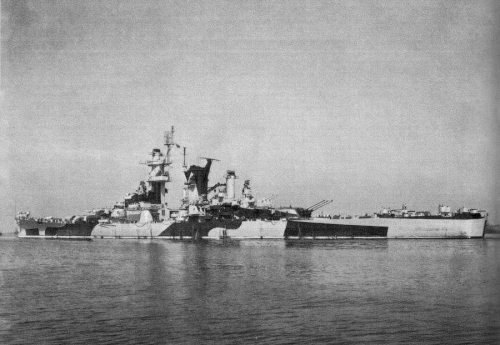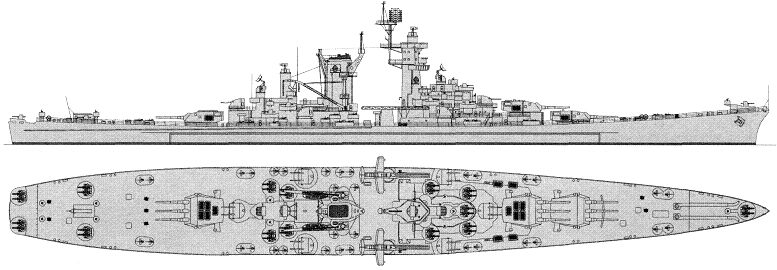
NAVYPEDIA
 Support the project with paypal
Support the project with paypal
Photo

Alaska 1944
Ships
| No | Name | Yard No | Builder | Laid down | Launched | Comm | Fate |
|---|---|---|---|---|---|---|---|
| CB1 | Alaska | 435 | New York SB, Camden | 17.12.1941 | 15.8.1943 | 176/1944 | stricken 1.6.1960 |
| CB2 | Guam | 436 | New York SB, Camden | 2.2.1942 | 12.11.1943 | 17.9.1944 | stricken 1.6.1960 |
| CB3 | Hawaii | 437 | New York SB, Camden | 20.12.1943 | 11.3.1945 | --- | suspended 9.1947, sold 1.1960 |
| CB4 | Philippines | 438 | New York SB, Camden | --- | --- | --- | cancelled 24.6.1943 |
| CB5 | Puerto Rico | 439 | New York SB, Camden | --- | --- | --- | cancelled 24.6.1943 |
| CB6 | Samoa | 440 | New York SB, Camden | --- | --- | --- | cancelled 24.6.1943 |
Technical data
| Displacement standard, t | 29779 |
|---|---|
| Displacement full, t | 34253 |
| Length, m | 241.3 wl 246.4 oa |
| Breadth, m | 27.8 |
| Draught, m | 9.70 full load |
| No of shafts | 4 |
| Machinery | 4 sets General Electric geared steam turbines, 4 Babcock & Wilcox boilers |
| Power, h. p. | 150000 |
| Max speed, kts | 33 |
| Fuel, t | oil 3619 |
| Endurance, nm(kts) | 12000 (15) |
| Armour, mm | belt: 229 - 127, main deck: 102 - 97, upper deck: 36, splinter deck: 16, barbettes: 330 - 278, turrets: 325 - 127, CT: 269 sides, 127 roof |
| Armament | 3 x 3 - 305/50 Mk 8, 6 x 2 - 127/38 Mk 12, 14 x 4 - 40/60 Mk 1.2, 34 x 1 - 20/70 Mk 4, 2 catapults, 4 seaplanes (SOC, OS2U) |
| Electronic equipment | CB1, 2: SK, 2x SG-1, 2x Mk 8, 2x Mk 12.22 radars |
| Complement | 1517 |
Standard scale images

Alaska 1944

Alaska 1944
Graphics
Project history
Big cruisers Alaska and Guam owing to their sizes and armament frequently referred to a class of battleships, however they conduct the origin from the 'Washington' cruisers, being their direct successors. The origin of these ships is obliged to several factors. First, with a beginning of war in Europe all treaties limitations became invalid, secondly financing of new shipbuilding programs did not meet Congress back action, thirdly, at that time the concept of "supercruiser" which could come to replace existing 'Washington' cruisers with 203mm main guns was popular. Designing (for her even the new CB subclass was created) was begun in 1940. As result of disappeared limits, ship became very huge. The requirement of high speed predetermined the big slenderness of the hull that not allowed to ensure a little effective underwater protection, besides presence of just only one rudder instead of two (that practized on battleships) predetermined bad manoeuvrability. On early design stages protection was assumed only against 203mm shells (except magazines, traditionally better protected), but then armour was strengthened, and as a result ships had immune zone under fire of 305mm guns in the range of 90-120 cables at a relative 60° bearing. It was originally supposed to arm ships by 8 305/50mm guns in twin and triple turrets, however as a result they have decided to place all guns in triple turrets to not waste time on working out of turrets of two types.
Under the FY1940 programme building of six ships of class was provided (CB1-6), however by 1943 the relation to this project begun to change for the worse, and three ships were cancelled. Building of СВ3 Hawaii was suspended in 1947
Ship protection
Main 134m belt was 4.6m high. It was 229mm thick (127mm at lower edge) and inclined at 10° to vertical. It was closed by 260mm bulkheads. Steering gear compartment had 270mm sides and bulkheads. Underwater protection was 3.0-2.4m deep. Main deck was 102-96mm thick over machinery and 108mm over magazines. 19-16mm splinter deck was one level lower and 36mm upper deck was one level higher. Steering gear had 38mm roof. Thickness of second deck over steering gear was 102mm. Barbettes were 330-278mm thick. Turrets had 325mm faces, 152-133mm sides, 133mm rears and 127mm crowns. CT had 269mm sides and 127mm roof.
Modernizations
None.
1.1946, both: 3 x 3 - 305/50 Mk 8, 6 x 2 - 127/38 Mk 32, 14 x 4 - 40/60 Mk 2, 34 x 1 - 20/70 Mk 10, 2 catapults, 4 seaplanes, SK, 2x SG-1, 2x Mk 8, 2x Mk 12.22 radars
Naval service
No significant events.
 HOME
HOME FIGHTING SHIPS OF THE WORLD
FIGHTING SHIPS OF THE WORLD UNITED STATES OF AMERICA
UNITED STATES OF AMERICA CRUISERS
CRUISERS ALASKA battlecruisers (1944)
ALASKA battlecruisers (1944)
